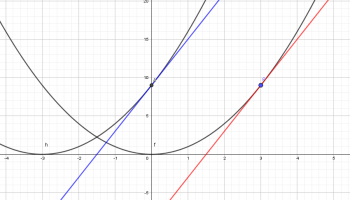BigBeachBanana
Senior Member
- Joined
- Nov 19, 2021
- Messages
- 2,274
I've recently stumbled on an interesting method of finding the tangent line to a polynomial through long division. If we want to find the tangent line at [imath]x=a[/imath] for some polynomial function [imath]f(x)[/imath], then divide [imath]f(x)[/imath] by [imath](x-a)^2[/imath] using long division. The remainder of the division is the tangent line at [imath]x=a[/imath] and has the form [imath]\alpha x+\beta[/imath]. I have verified this technique with different polynomials, and it all seemed to work. I'm looking for some theory behind this method (no luck on the internet).
Example: Find the tangent line at [imath]x=2[/imath] of [imath]f(x)=5x^3-4x+7[/imath].
Divide [imath]f(x)=5x^3-4x+7[/imath] by [imath](x-2)^2=x^2-4x+4[/imath]. We get a remainder of [imath]56x+73[/imath], which is, in fact, the tangent line.
Why does it work? Does it work for all polynomials?
Example: Find the tangent line at [imath]x=2[/imath] of [imath]f(x)=5x^3-4x+7[/imath].
Divide [imath]f(x)=5x^3-4x+7[/imath] by [imath](x-2)^2=x^2-4x+4[/imath]. We get a remainder of [imath]56x+73[/imath], which is, in fact, the tangent line.
Why does it work? Does it work for all polynomials?
Last edited:


